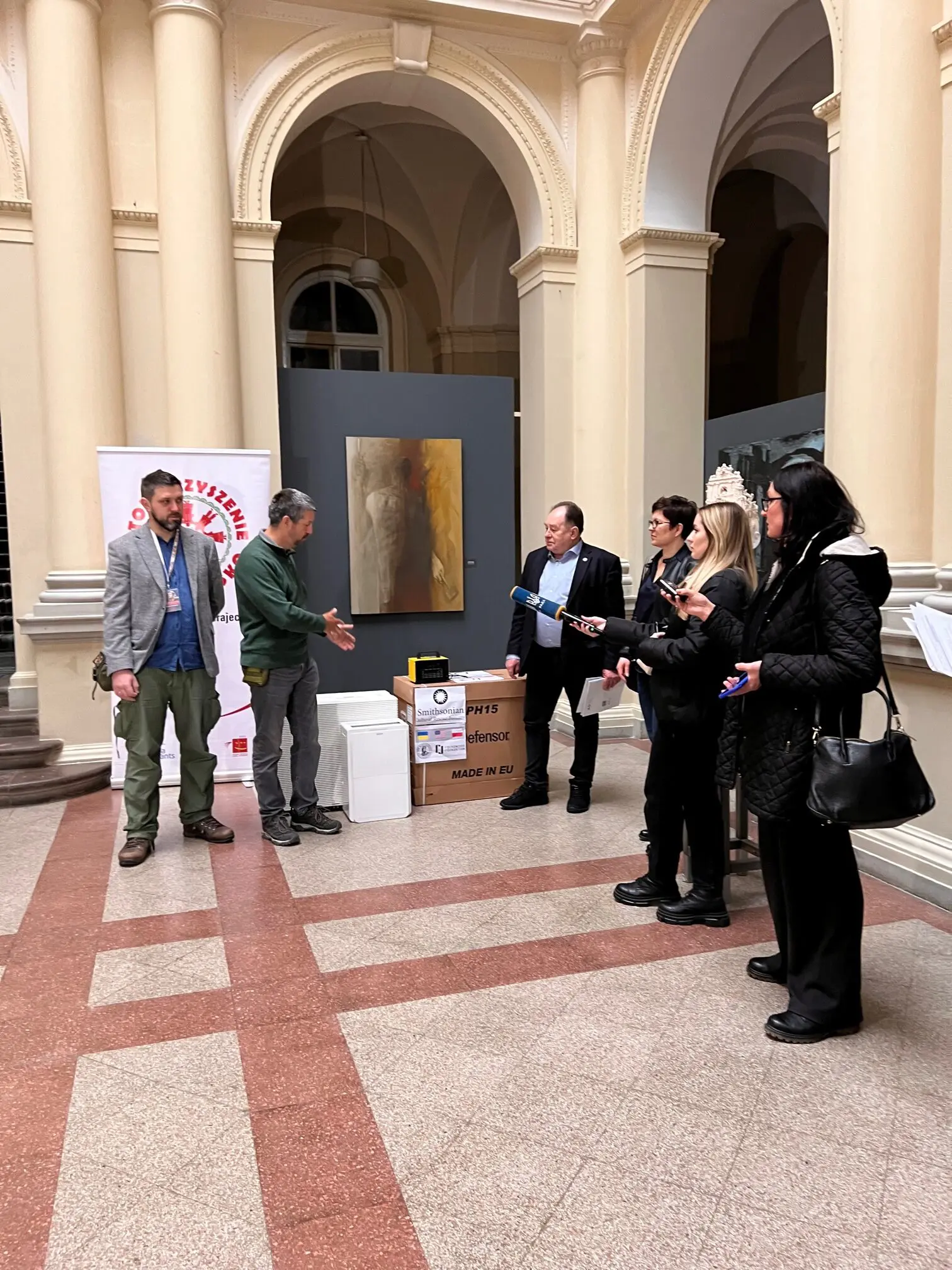“U.S. and Polish Organizations Are Helping to Rescue Ukraine’s Cultural Heritage” – The KF in Radio Free Europe/Radio Liberty

LVIV – The Smithsonian Institution and the Kosciuszko Foundation in the United States, together with the Polish Foundation Folkowisko have joined forces to help protect and preserve Ukrainian cultural heritage artifacts and to prevent their destruction during the Russia-Ukraine war. The majority of the art pieces, particularly in Lviv, have been evacuated and need to be stored in favorable conditions.
The article was originally published on February 28, 2023, by Radio Svoboda (Radio Free Europe/Radio Liberty) at https://www.radiosvoboda.org/a/dopomoha-spadshchyna-viyna-kultura/32291369.html
Author: Halyna Tereshchuk
English translation: Anna Chukur, PhD
The exhibition rooms of the Andrey Sheptytsky National Museum in Lviv have been empty for over a year. The museum’s main exhibitions were removed in the early days of the full-scale war, and only thematic exhibits are being organized.
The National Museum in Lviv was the first institution to receive assistance from the Smithsonian Institution and the Kosciuszko Foundation in the U.S., as well as the Polish Foundation Folkowisko. Professional humidifiers and dehumidifiers, as well as ozone generators were purchased for the Lviv museum using the funds raised in the USA. This equipment is intended for repositories that store ancient wooden sculptures, icons and paintings. For a year now, these pieces have not been exhibited due to Russia’s large-scale invasion of Ukraine. Museum staff moved them to safer locations for storage. In order to preserve these unique works of art, it is necessary to maintain optimal humidity levels and air temperature, as excessive humidity, in particular in basements, degrades the artworks. Overly dry air damages canvas paintings and icons.
Danuta Posatska, the chief conservator of the Andrey Sheptytsky National Museum in Lviv, recalls how staff evacuated museum artworks in the early days of the war.
“The museum became empty. Even before those events, we used special equipment and tried to protect the museum collections. But then power outages began due to Russian shelling. Therefore, I remembered traditional methods and created a humid environment myself. I brought heavy sweaters and hung them on the window grates. As the air was circulating through these damp sweaters and drying them, they would release moisture into the repository and provide the humidity that the works needed. There should be at least 50% humidity in the repository. The facility has a stone floor, and I used it to increase the humidity as well. This is how I used traditional methods to preserve the artwork. The methods may be simplistic, but when there is no electricity, they are a lifesaver. Icons need humidity, and so do artistic objects produced with wood,” said Posatska.
New equipment, purchased by U.S. and Polish foundations and valued at more than 1.5 million hryvnias (approximately US $40,600), will keep the custodians from needing to resort to such traditional methods of maintaining the proper humidity in the repositories.
The Smithsonian Institution, founded in the first half of the 19th century, consists of more than 20 museums, as well as educational, cultural, and research centers.
It assists scholars and is dedicated to protecting culture in crisis situations. This institution believes that the protection of cultural heritage, including works of art, historical sites, and traditions, is important in preserving the identity of the people. The Smithsonian Institution appealed to the Kosciuszko Foundation in Washington to jointly help Ukraine, where museums and cultural heritage artifacts have been destroyed due to the Russian invasion.
The president of the Kosciuszko Foundation (New York, USA), Polish American Marek Skulimowski, was in Poland, his homeland, in the early days of Russia’s full-scale invasion of Ukraine. He immediately became actively involved in helping Ukrainians. At first, he provided help at the border, where hundreds of thousands of Ukrainian refugees were crossing.
“I stayed near the Polish-Ukrainian border and was visiting my ancestral home. In the first weeks, we brought in all the aid and transported people. No one could have imagined such a situation. We saw pictures from the Second World War. But then we started thinking about something larger. We started collecting funds at lightning speed. These funds were allocated for humanitarian aid at the border, and later for educational programs, providing grants for over 50 Ukrainian scholars who fled the war, as well as for artists. We also organized camps for Ukrainian children who studied English with Polish children. The children spent time together. During the year of the war in Ukraine, we did more to unite and bring Ukrainians and Poles closer together than in the last 30 years,” Skulimowski recounts.
Skulimowski is a descendant of Poles who lived in the territory of modern Ukraine before the Second World War. He emphasizes that the destruction of cultural heritage is ongoing, as it previously happened in the 20th century when a large portion of Polish cultural heritage in Ukraine was also destroyed.
“Works of art have been evacuated today and are not exhibited in museum halls. The wooden sculptures were moved to the cellars; they have been stored there for a long time in unfavorable conditions, which damages the artworks. Ukrainian, Polish, and Jewish cultural heritage were uniquely integrated in Ukraine. I hope that this barbaric, imperialist war which aims to destroy Ukrainian culture and language will end, and we will be helping in another way, because the time will come for the development of the institutions,” said Skulimowski.
More than 30 Ukrainian museums will receive assistance
This is only the first batch of aid for the Lviv museum. According to the director of the Andrey Sheptytsky National Museum, Ihor Kozhan, the museum will also receive equipment for digitization and preservation of its collections.
“We were lucky that the winter was mild. The objects in storage remain in good condition and power outages have not damaged the works of art. In museums, special devices maintain climate control. This new equipment that we received has saved the artworks. The equipment automatically maintains the set humidity level. Paintings, wooden sculptures, graphics, fabric, and paper need a certain level of humidity for storage,” said Kozhan.
More than 30 museums, not only in Lviv, but also in Kyiv, Odesa, Kharkiv, Dnipro, Zaporizhzhia, and Kryvyi Rih, will receive such assistance in the form of equipment from U.S. foundations.
“This is a war for the Ukrainian language and culture; thus, it is imperative to remember that it is important to support the army as well as culture. From the first day, we provided humanitarian aid and ambulances to Ukraine, and now we want to protect the cultural heritage of Ukraine. Ukrainian culture is important to us, and we are helping. We helped theaters by providing them with generators. We must tell the world about Ukraine, tell them that Ukrainians are fighting and protecting the world,” said Marcin Piotrowski, head of the Polish Foundation Folkowisko.
The Folkowisko Foundation was created in the borderland village of Gorajec. The history of this village is very complex and tragic. Before the Second World War, the population of the village was mostly Ukrainians along with Poles, but the war brought tragedy. The Ukrainian population, which was native to the village, was forcibly deported in 1945 and during Operation Vistula in 1947.
“Over the last year, we have done more for Ukrainian-Polish cooperation than we have done in the last 30 years. We sent 4,000 tons of humanitarian aid to Ukraine. We work on various fronts, and 24 February 2022 became a day of new challenges for us. We do not want future generations of Ukrainians to live with the trauma of this modern war, as was the case during the Second World War. We want to address this trauma now and are doing a lot of work so that it does not intensify. Ukrainians attend psychological trainings conducted by experts from Israel who have experience in overcoming the trauma of war,” said Piotrowski.
According to the latest UNESCO data, Russia destroyed more than 550 pieces of Ukrainian cultural heritage. Almost 240 of them have been verified by UNESCO experts. For instance, more than 70 cultural objects were destroyed in Chernihiv alone in less than five weeks. The Ukrainian authorities reported that during the year of the full-scale war Russia looted museums and churches in Ukraine, seized works of art, and destroyed monuments.
Correspondents of Radio Svoboda (the Ukrainian service of Radio Free Europe/Radio Liberty) reported that pieces from the Kherson Museum were taken to museums in occupied Crimea and Russia. Local residents say that the Russian occupying forces even raided the homes of art collectors and looted art pieces from antique shops. According to their employees, almost all of the objects from the Kherson Art Museum and the Kherson Local History Museum have been seized. The exhibition rooms are empty.
At the beginning of February, 2023, the Ministry of Culture and Information Policy and the National Agency for the Prevention of Corruption announced the launch of initiatives to prevent illegal trade of art objects that were stolen by the Russian military in Ukraine.
Captions of the photos published with the original article by Radio Svoboda:
Caption 1: A damaged monument commemorating Taras Shevchenko and a destroyed armored personnel carrier (APC) in the village of Cherkaski Tyshky in Kharkiv region during Russia’s large-scale invasion of Ukraine, 23 October 2022
Caption 2: The National Museum in Lviv moved its collections into a shelter during the war
Caption 3: The Andrey Sheptytsky National Museum in Lviv
Caption 4: Marek Skulimowski (right) and Marcin Piotrowski
Caption 5: The Kherson Local History Museum was looted





